Improved Support Vector Machine for Voiceprint Diagnosis of Typical Faults in Power Transformers
Abstract
:1. Introduction
2. Fault Diagnosis Principle of CEEMDAN-HPO-SVM
2.1. CEEMDAN
- The signal obtained by adding Gaussian white noise to the original signal and EMD decomposition is performed on the signal to obtain . The average value is calculated after decomposition, which is the first modal component, as shown in Equations (1) and (2).where k represents the number of times white noise was added, and represents the first white noise.
- The first residual component is obtained by subtracting the first modal component from the original signal , as shown in Equation (3).
- the jth component is defined, and Gaussian white noise is added to the first residual component to perform a second decomposition of the mixed signal, as shown in Equation (4).where represents the added Gaussian white noise, and represents the obtained second modal component.
- For the l-th residual component (, where L is the maximum decomposition order), as shown in Equation (5).
- The above operations are repeated until EMD is unable to decompose the residual signal to obtain the final solution of the original signal, as shown in Equation (6).
2.2. Envelope Spectral Kurtosis
2.3. SVM
2.4. HPO
- The population position is initialized, and hunters or prey in space are randomly generated, as shown in Equation (10).where represents the position of population members, d represents the dimension of the problem, and u and l represent the upper and lower bounds of the problem variables, respectively.
- Introducing a hunter search mechanism, hunters choose prey far from the group as their hunting targets, as shown in Equation (11).where represents the current position of the hunter, represents the next position of the hunter, represents the position of the target prey, represents the average position between the hunter and the prey, Z is the adaptive parameter, W is the equilibrium parameter in algorithm exploration, and its calculation process is shown in Equation (12).where t represents the number of iterations, and tmax represents the maximum number of iterations.
- A prey escape mechanism is introduced. The prey moves to the global optimal position to avoid the hunter’s search to escape hunting, as shown in Equation (13).where represents the current position of the prey, represents the next position of the prey, is the target position of the prey (global optimal position), and R is a random number within the range of [−1,1].
- Combining Equations (11) and (13) to obtain the algorithm’s selection mechanism for hunter-prey behavior, an adjustment parameter is set, and the random numbers R1 and between [0,1] are compared; if R1 is less than , the hunter search mechanism is executed. On the contrary, the prey escape mechanism is triggered until the conditions are met and the optimization is completed. In this paper, the regulating parameter is set as 0.1. Figure 1 is a schematic diagram of the location of hunters searching for prey and the process of prey escape.
3. CEEMDAN-HPO-SVM Diagnostic Process
4. CEEMDAN Fault Feature Extraction
5. Experimental Verification
5.1. Data Collection
5.2. Model Parameter Selection
5.3. Experimental Results and Analysis
6. Conclusions
- The transformer voiceprint signal is susceptible to interference from transmission path coupling noise during transmission. To address this issue, the use of CEEMDAN can achieve the separation of fault voiceprint information and transmission path interference factors and combine the envelope spectral kurtosis index to characterize voiceprint information in the frequency domain, achieving accurate extraction of fault information components.
- The population optimization algorithm can improve the diagnostic ability of SVM for feature overlap problems by optimizing the parameters of SVM kernel functions C and g. The HPO algorithm has higher iteration efficiency and optimization ability compared to GWO and ACO algorithms, which can improve the generalization performance of the model, and combining the SVM algorithm can achieve good pattern recognition results.
Author Contributions
Funding
Institutional Review Board Statement
Informed Consent Statement
Data Availability Statement
Conflicts of Interest
References
- Sun, X. Numerical analysis of an exponentially ill-conditioned boundary value problem with applications to metastable problems. IMA J. Numer. Anal. 2001, 21, 817–842. [Google Scholar] [CrossRef]
- Li, Z.; Jiao, Z.; He, A.; Xu, N. A denoising-classification neural network for power transformer protection. Prot. Control. Mod. Power Syst. 2022, 7, 52. [Google Scholar] [CrossRef]
- Chernov, A.; Butakova, M.; Kostyukov, A.; Kartashov, O. Intelligent Framework and System for Remote Monitoring and Prediction of Power Transformer Conditions. In Proceedings of the 21st International Multidisciplinary Conference on Reliability and Statistics in Transportation and Communication (RelStat), Riga, Latvia, 14–15 October 2021; pp. 321–330. [Google Scholar]
- Yao, D.; Li, L.; Zhang, S.; Zhang, D.; Chen, D. The Vibroacoustic Characteristics Analysis of Transformer Core Faults Based on Multi-Physical Field Coupling. Symmetry 2022, 14, 544. [Google Scholar] [CrossRef]
- Zhang, L.; Sheng, G.; Hou, H.; Jiang, X. A Fault Diagnosis Method of Power Transformer Based on Cost Sensitive One-Dimensional Convolution Neural Network. In Proceedings of the 2020 5th Asia Conference on Power and Electrical Engineering (ACPEE), Chengdu, China, 9–12 April 2020; pp. 1824–1828. [Google Scholar]
- Wang, Y.; Li, X.; Ma, J.; Li, S. Fault diagnosis of power transformer based on fault-tree analysis (FTA). In Proceedings of the International Symposium on Resource Exploration and Environmental Science, Ordos, China, 14–16 April 2017. [Google Scholar]
- Jin, L.; Kim, D.; Abu-Siada, A.; Kumar, S. Oil-Immersed Power Transformer Condition Monitoring Methodologies: A Review. Energies 2022, 15, 3379. [Google Scholar] [CrossRef]
- Yu, D.; Zhang, W.; Wang, H. Research on Transformer Voiceprint Anomaly Detection Based on Data-Driven. Energies 2023, 16, 2151. [Google Scholar] [CrossRef]
- Tianlu, C.; Gui, Y.; Ali, S.; Pei, W. Feature extraction and selection for defect classification of pulsed eddy current NDT. NDT E Int. 2008, 41, 6. [Google Scholar]
- Mian, T.; Choudhary, A.; Fatima, S. Vibration and infrared thermography based multiple fault diagnosis of bearing using deep learning. Nondestruct. Test. Eval. 2023, 38, 2. [Google Scholar] [CrossRef]
- Chen, L.; Zhi, X.; Wang, H.; Wang, G.; Zhou, Z.; Yazdani, A.; Zheng, X. Driver Fatigue Detection via Differential Evolution Extreme Learning Machine Technique. Electronics 2020, 9, 1850. [Google Scholar] [CrossRef]
- Jiang, F.; Kutia, M.; Sarkissian, A.J.; Lin, H.; Long, J.; Sun, H.; Wang, G. Estimating the Growing Stem Volume of Coniferous Plantations Based on Random Forest Using an Optimized Variable Selection Method. Sensors 2020, 20, 7248. [Google Scholar] [CrossRef] [PubMed]
- Pietrzak, P.; Wolkiewicz, M. On-line Detection and Classification of PMSM Stator Winding Faults Based on Stator Current Symmetrical Components Analysis and the KNN Algorithm. Electronics 2021, 10, 1786. [Google Scholar] [CrossRef]
- Liu, B.; Zhou, Y.; Feng, L.; Fu, H.; Fu, P. Hybrid CNN-SVM Inference Accelerator on FPGA Using HLS. Electronics 2022, 11, 2208. [Google Scholar] [CrossRef]
- Li, X.; Liao, X.; Lu, D.; Qiu, Z. A Robust Classification Method for Power Transformer Status Recognition Based on Sound Signals. In Proceedings of the 2021 5th International Conference on Power and Energy Engineering (ICPEE), Xiamen, China, 2–4 December 2021; pp. 153–157. [Google Scholar]
- Li, X.; Li, Y.; Xu, Y.; Li, R.; Zhang, G. Fault Diagnostics of Oil-immersed Power Transformer via SMOTE and GWO-SVM. In Proceedings of the 2022 4th Asia Energy and Electrical Engineering Symposium (AEEES), Chengdu, China, 25–28 March 2022; pp. 935–939. [Google Scholar]
- Duan, P.; Yang, Z.; He, Y.; Zhang, B.; Zhang, L.; Liu, F.; Shi, Y. Research on Identification of Magnetizing Inrush Current Based on PSO-SVM. In Proceedings of the 2022 4th Asia Energy and Electrical Engineering Symposium (AEEES), Chengdu, China, 25–28 March 2022; pp. 630–634. [Google Scholar]
- Zhou, Y.; Liu, Y.; Wang, N.; Han, X.; Li, J. Partial discharge ultrasonic signals pattern recognition in transformer using BSO-SVM based on microfiber coupler sensor. Measurement 2022, 201, 111737. [Google Scholar] [CrossRef]
- Li, L.; Meng, W.; Liu, X.; Fei, J. Research on Rolling Bearing Fault Diagnosis Based on Variational Modal Decomposition Parameter Optimization and an Improved Support Vector Machine. Electronics 2023, 12, 1290. [Google Scholar] [CrossRef]
- Hu, Y.; Yi, O.; Wang, Z.; Yu, H.; Liu, L. Vibration signal denoising method based on CEEMDAN and its application in brake disc unbalance detection. Mech. Syst. Signal Process. 2023, 187, 109972. [Google Scholar] [CrossRef]
- Zhu, X.; Guo, H.; Huang, J.J.; Tian, S.; Zhang, Z. A hybrid decomposition and Machine learning model for forecasting Chlorophyll-a and total nitrogen concentration in coastal waters. J. Hydrol. 2023, 619, 129207. [Google Scholar] [CrossRef]
- Lin, Y.; Lin, Z.; Liao, Y.; Li, Y.; Xu, J.; Yan, Y. Forecasting the realized volatility of stock price index: A hybrid model integrating CEEMDAN and LSTM. Expert Syst. Appl. 2022, 206, 117736. [Google Scholar] [CrossRef]
- Han, S.; Jin, Z.; Deji, D.; Han, T.; Zhang, Y.; Feng, M.; Hasi, W. Study on the classification and identification of various carbonate and sulfate mineral medicines based on Raman spectroscopy combined with PCA-SVM algorithm. Anal. Sci. 2022, 14, 1. [Google Scholar] [CrossRef]
- Zhou, J.; Yang, P.; Peng, P.; Khandelwal, M.; Qiu, Y. Performance Evaluation of Rockburst Prediction Based on PSO-SVM, HHO-SVM, and MFO-SVM Hybrid Models. Mining. Metall. Explor. 2023, 40, 617–635. [Google Scholar]
- Duan, Z.; Liu, T. Short-Term Electricity Price Forecast Based on SSA-SVM Model. In Advanced Intelligent Technologies for Industry; Springer Nature: Singapore, 2022; Volume 285. [Google Scholar]
- Naruei, I.; Keynia, F.; Sabbagh, M.A. Hunter–prey optimization: Algorithm and applications. Soft Comput. 2022, 26, 1279–1314. [Google Scholar] [CrossRef]
- Elshahed, M.; El-Rifaie, A.M.; Tolba, M.A.; Ginidi, A.; Shaheen, A.; Mohamed, S.A. An Innovative Hunter-Prey-Based Optimization for Electrically Based Single-, Double-, and Triple-Diode Models of Solar Photovoltaic Systems. Mathematics 2022, 10, 4625. [Google Scholar] [CrossRef]
- Petrović, K.; Petošić, A.; Župan, T. Grid-like Vibration Measurements on Power Transformer Tank during Open-Circuit and Short-Circuit Tests. Energies 2022, 15, 492. [Google Scholar] [CrossRef]
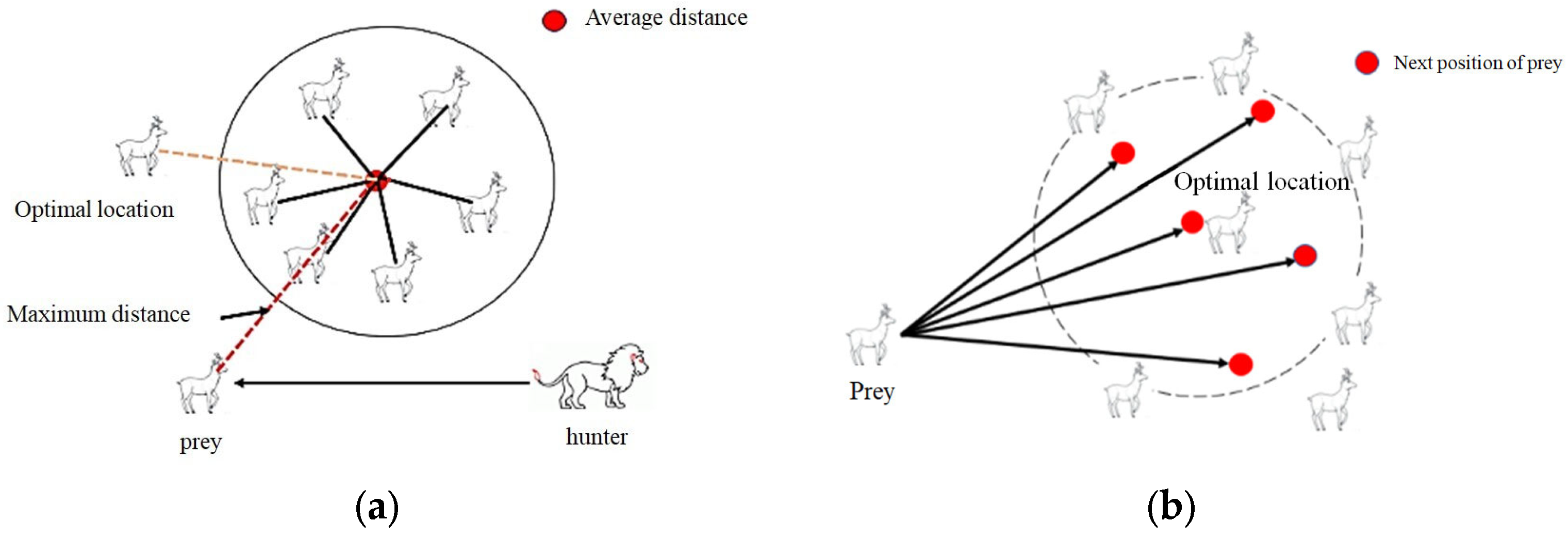
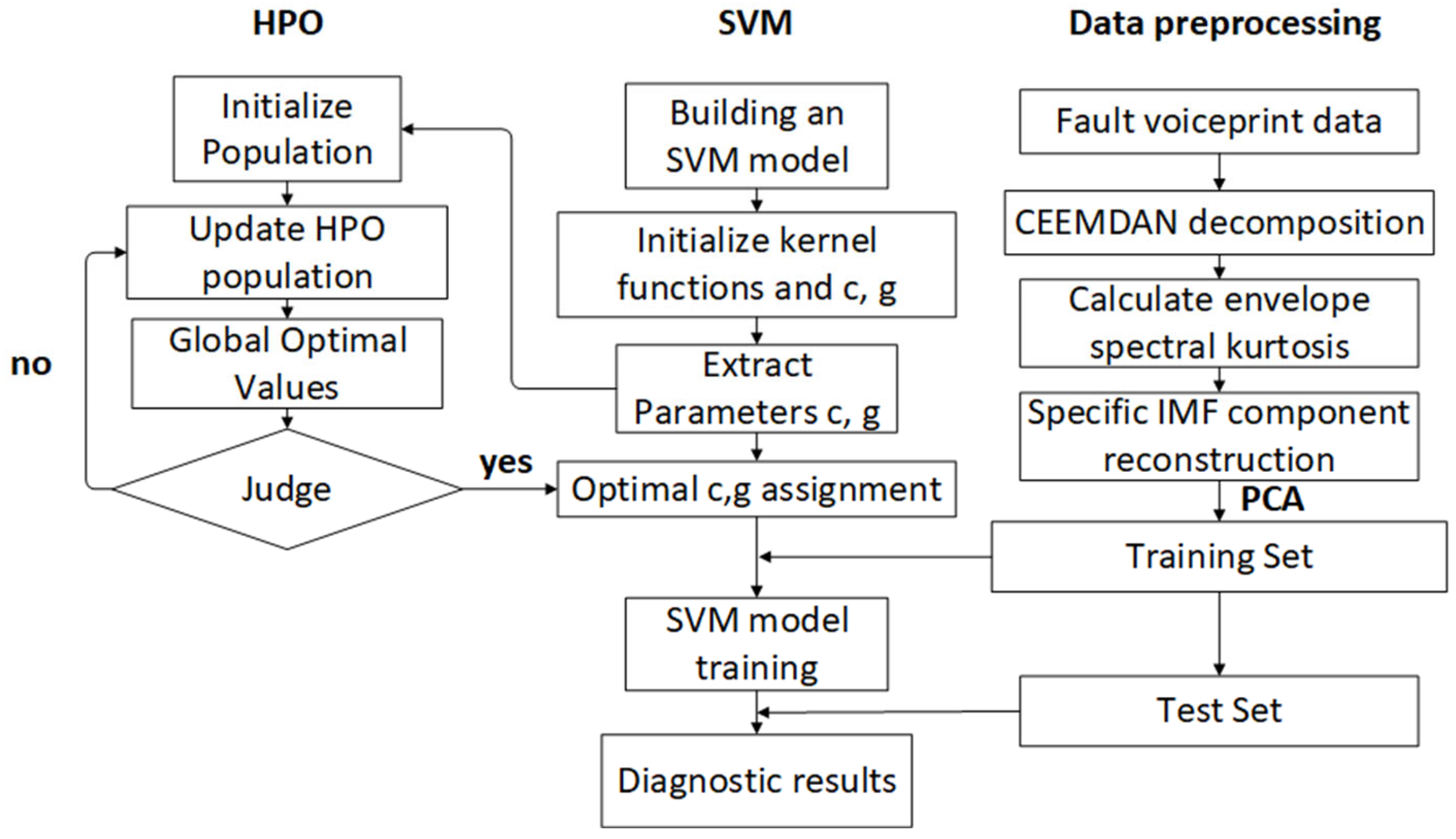
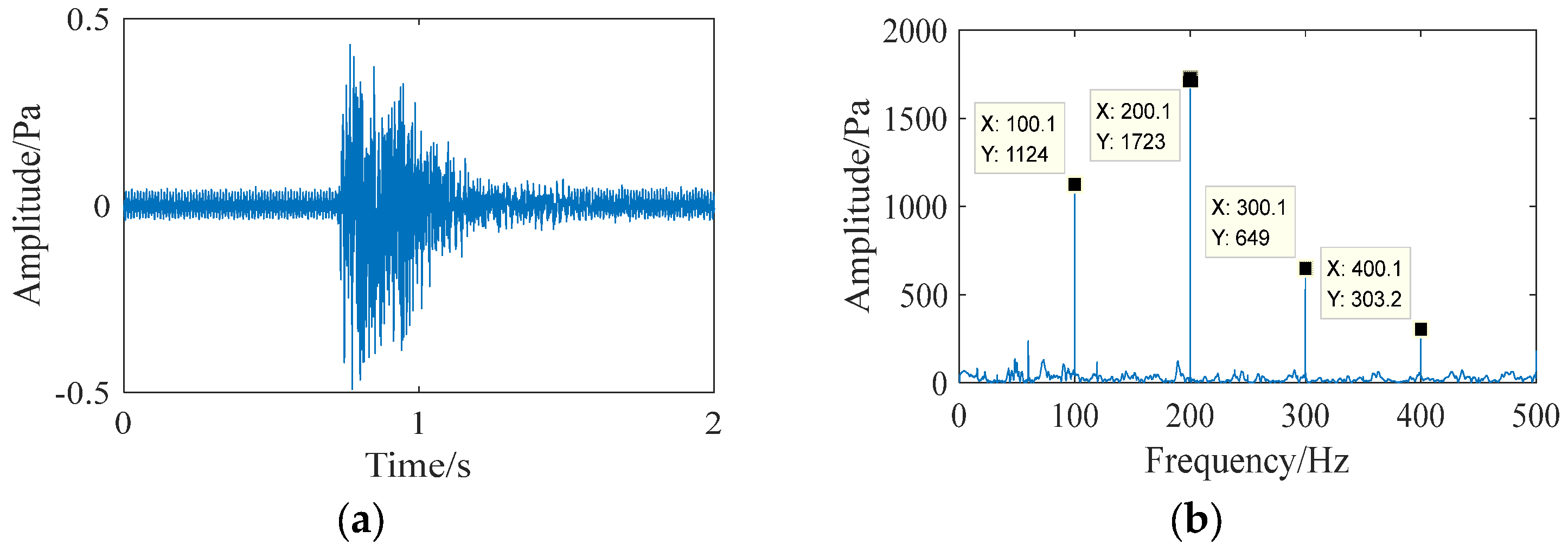
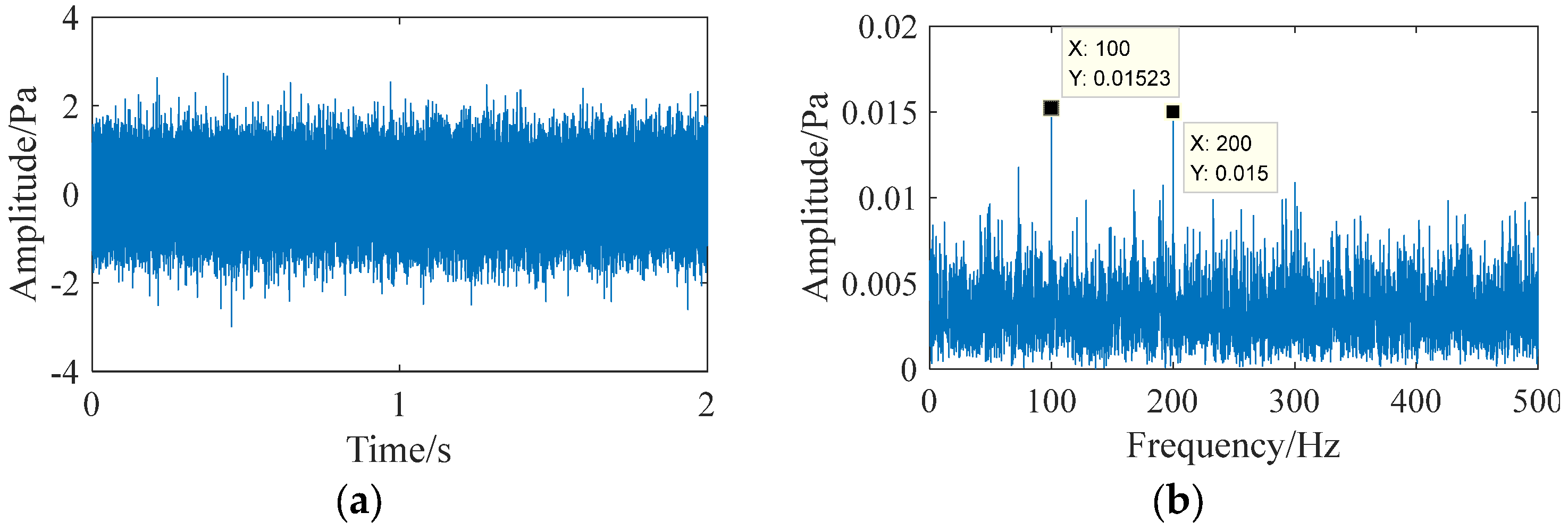
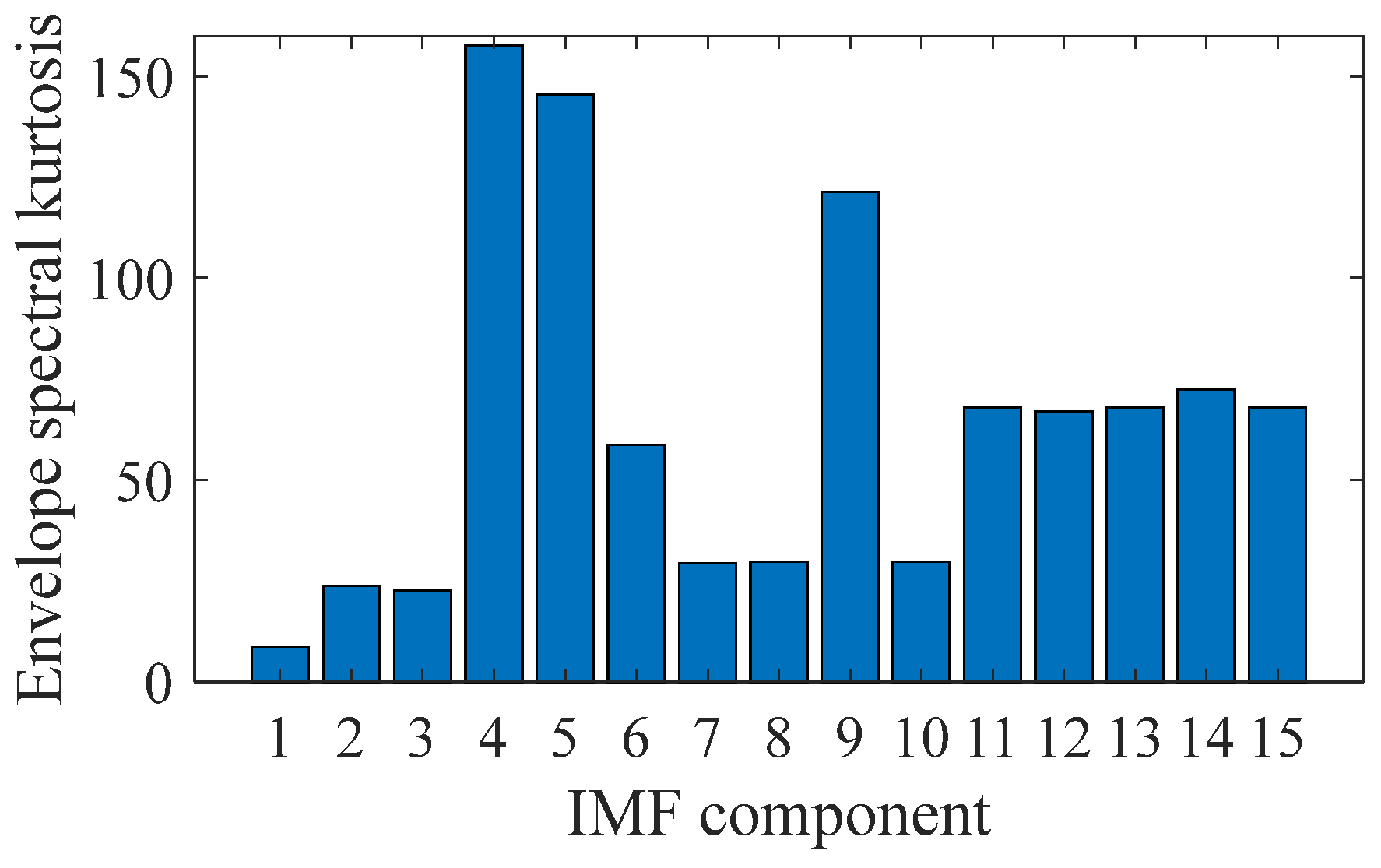

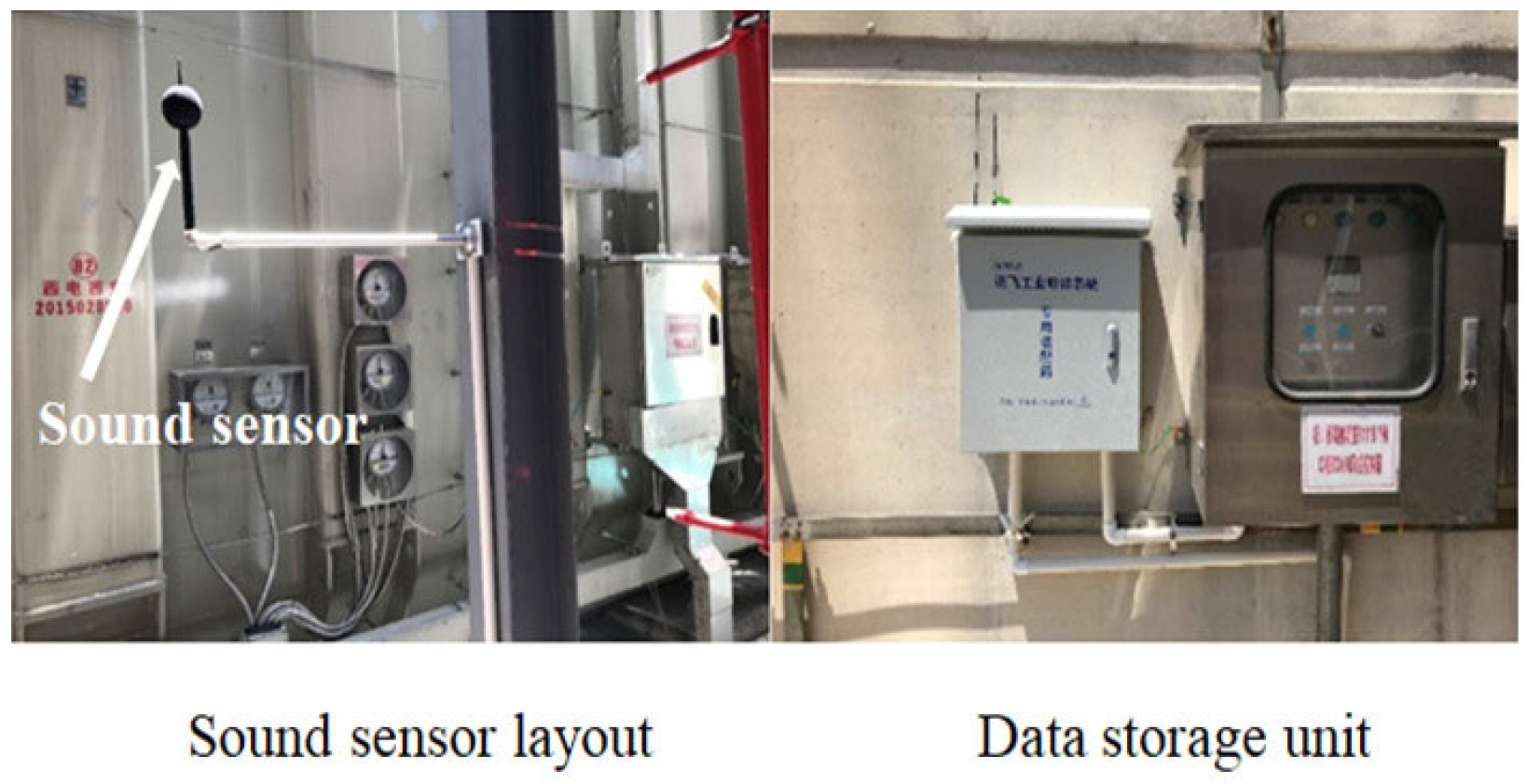
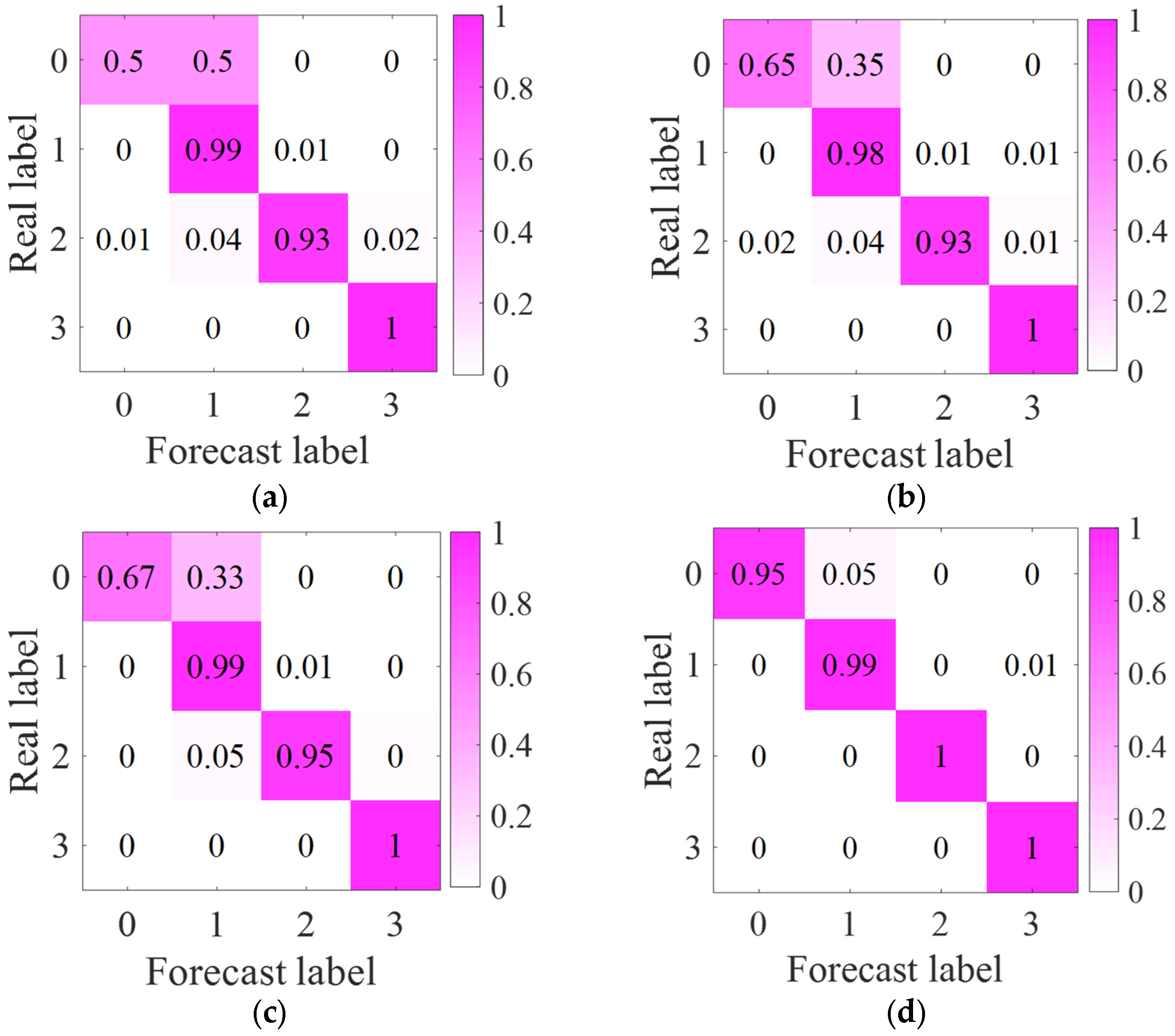
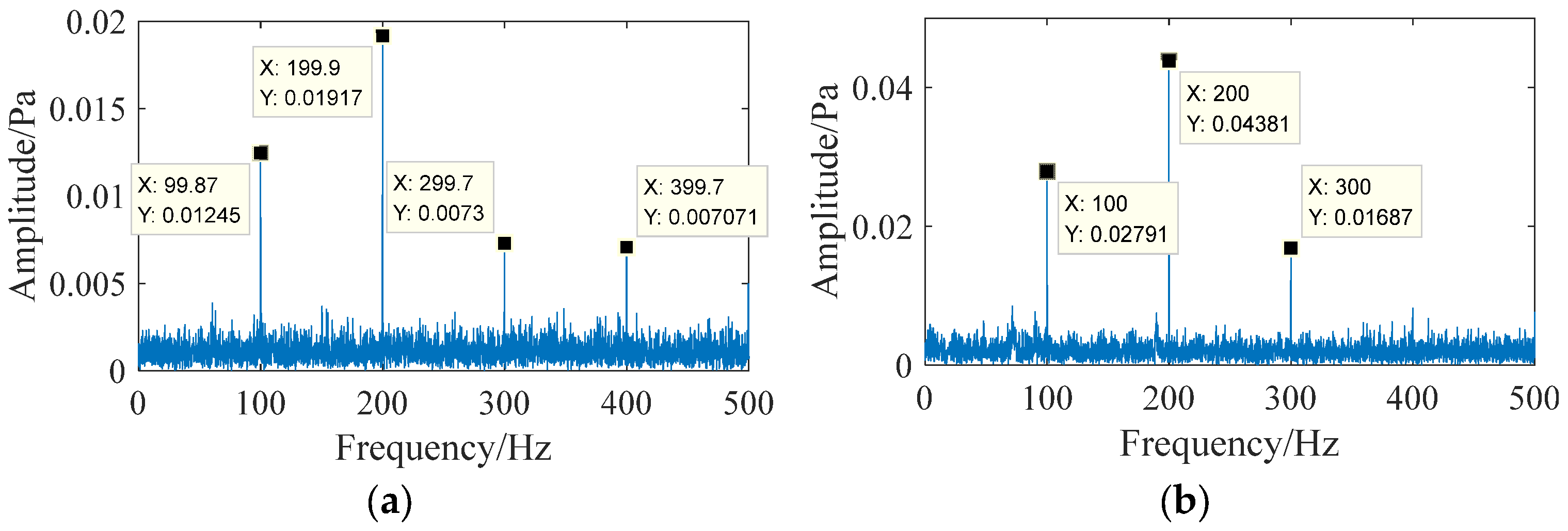
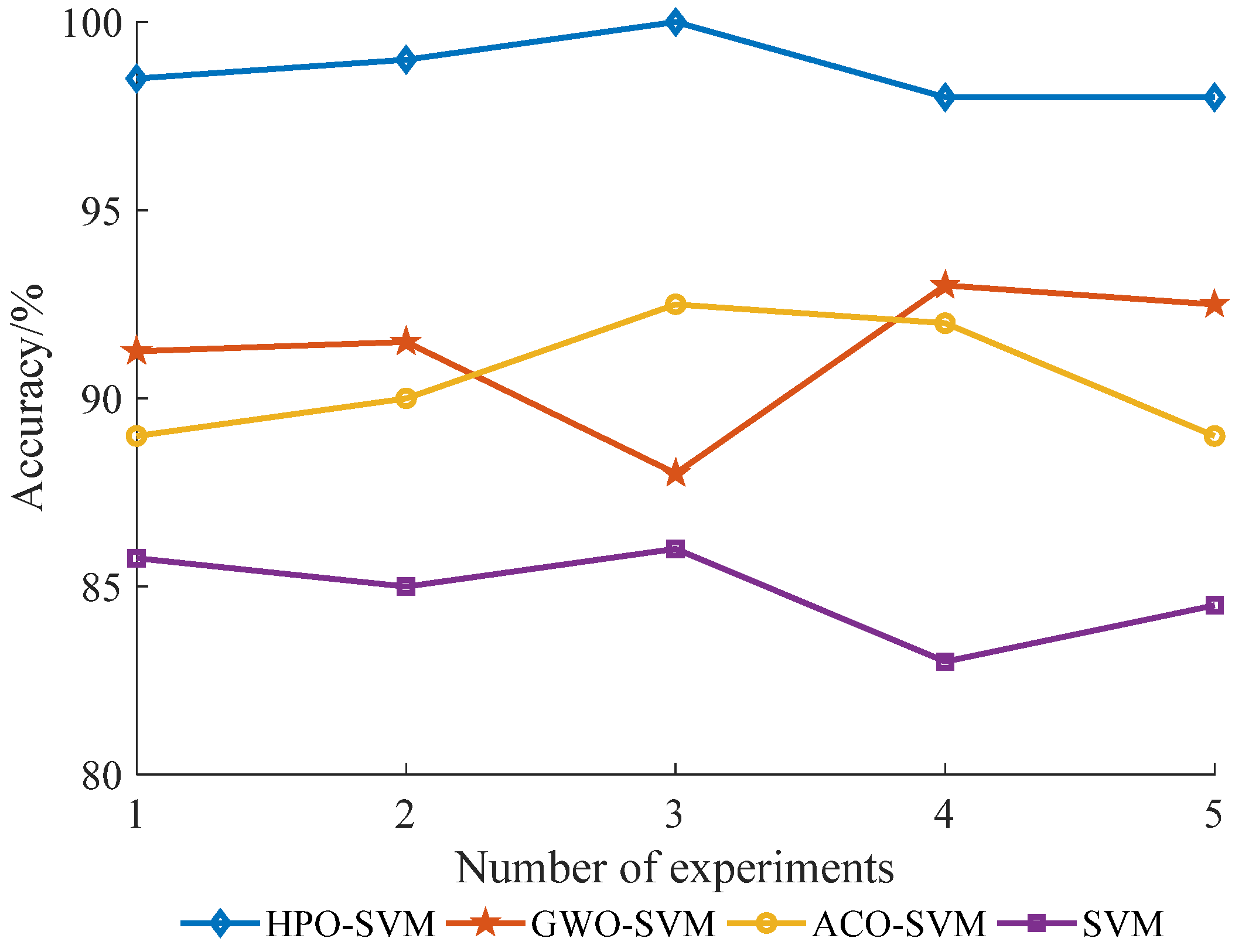
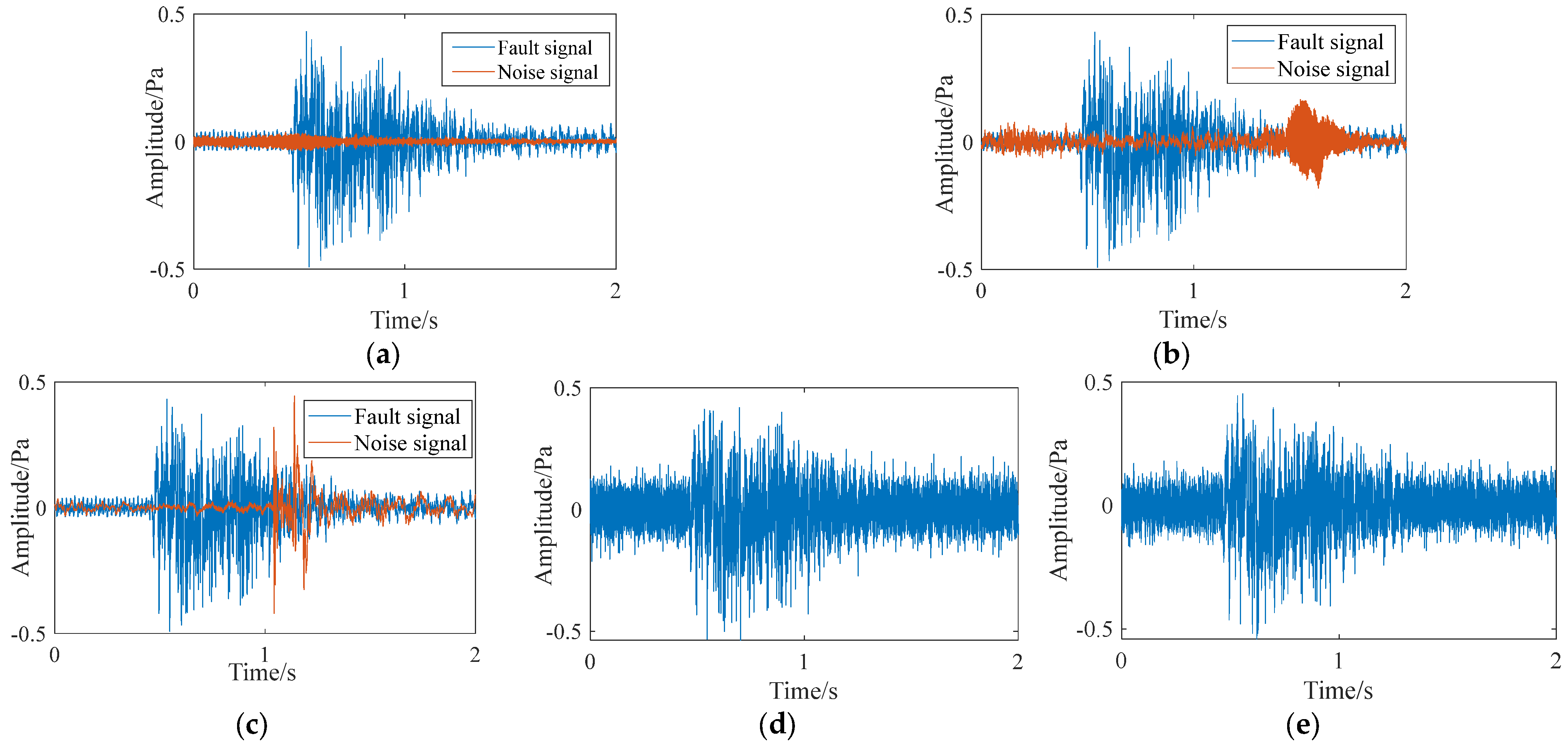

| Fault Number | Fault Type | Training Set (3/5) | Validation Set (1/5) | Test Set (1/5) |
|---|---|---|---|---|
| 0 | normal | 180 | 60 | 60 |
| 1 | Short circuit impact | 180 | 60 | 60 |
| 2 | Partial discharge | 180 | 60 | 60 |
| 3 | DC bias | 180 | 60 | 60 |
| PCA Number | Feature Number | Contribution Rate/% | Accumulated Contribution Rate/% |
|---|---|---|---|
| 1 | A4 | 53.2627 | 53.2627 |
| 2 | A8 | 25.5323 | 78.7950 |
| 3 | A1 | 7.7425 | 86.5375 |
| 4 | A3 | 3.5361 | 89.8936 |
| 5 | A6 | 2.6249 | 92.5185 |
| 6 | A5 | 2.1356 | 94.6541 |
| 7 | A9 | 2.0125 | 96.6666 |
| 8 | A7 | 1.8921 | 98.5587 |
| 9 | A2 | 0.9562 | 99.5149 |
| 10 | A10 | 0.4851 | 100.0000 |
| Classifier | C | g | Iteration Time/s | Accuracy/% |
|---|---|---|---|---|
| HPO-SVM | 5.8626 | 0.0786 | 7 | 98.50 |
| GWO-SVM | 6.9510 | 0.0720 | 25 | 90.25 |
| ACO-SVM | 1.0 | 0.0856 | 36 | 89.00 |
| Method/Noise Number | 1/% | 2/% | 3/% | 4/% | 5/% |
|---|---|---|---|---|---|
| Standard SVM | 80.75 | 68.75 | 73.00 | 63.50 | 79.55 |
| GWO-SVM | 91.25 | 77.00 | 80.25 | 69.25 | 91.50 |
| ACO-SVM | 90.25 | 78.00 | 86.50 | 74.75 | 91.25 |
| HPO-SVM | 97.25 | 92.00 | 92.25 | 86.25 | 95.50 |
Disclaimer/Publisher’s Note: The statements, opinions and data contained in all publications are solely those of the individual author(s) and contributor(s) and not of MDPI and/or the editor(s). MDPI and/or the editor(s) disclaim responsibility for any injury to people or property resulting from any ideas, methods, instructions or products referred to in the content. |
© 2023 by the authors. Licensee MDPI, Basel, Switzerland. This article is an open access article distributed under the terms and conditions of the Creative Commons Attribution (CC BY) license (https://creativecommons.org/licenses/by/4.0/).
Share and Cite
Wang, J.; Zhao, Z.; Zhu, J.; Li, X.; Dong, F.; Wan, S. Improved Support Vector Machine for Voiceprint Diagnosis of Typical Faults in Power Transformers. Machines 2023, 11, 539. https://doi.org/10.3390/machines11050539
Wang J, Zhao Z, Zhu J, Li X, Dong F, Wan S. Improved Support Vector Machine for Voiceprint Diagnosis of Typical Faults in Power Transformers. Machines. 2023; 11(5):539. https://doi.org/10.3390/machines11050539
Chicago/Turabian StyleWang, Jianxin, Zhishan Zhao, Jun Zhu, Xin Li, Fan Dong, and Shuting Wan. 2023. "Improved Support Vector Machine for Voiceprint Diagnosis of Typical Faults in Power Transformers" Machines 11, no. 5: 539. https://doi.org/10.3390/machines11050539
APA StyleWang, J., Zhao, Z., Zhu, J., Li, X., Dong, F., & Wan, S. (2023). Improved Support Vector Machine for Voiceprint Diagnosis of Typical Faults in Power Transformers. Machines, 11(5), 539. https://doi.org/10.3390/machines11050539





